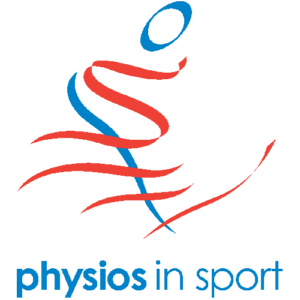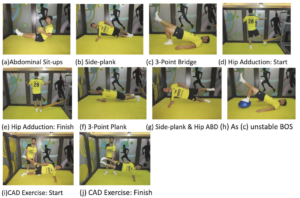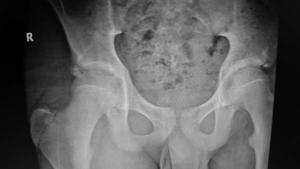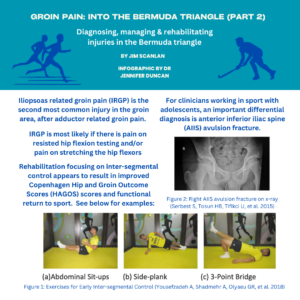Diagnosing, managing & rehabilitating injuries in the Bermuda Triangle
Keywords: Groin Pain; Iliopsoas; Rehabilitation

Introduction
Iliopsoas related groin pain (IRGP), , is the second most common injury in the groin area, after adductor related groin pain (ARGP)(1), (2) & (3). This blog is the second in a series discussing some of the complexities of diagnosing, managing and rehabilitating groin injuries; this part focusing on IRGP.
Iliopsoas Related Groin Pain (IRGP)
IRGP is defined as iliopsoas tenderness and is most likely if there is pain on resisted hip flexion testing and/or pain on stretching the hip flexors (4). Within the literature there is insufficient evidence to recommend a specific exercise protocol or modality (5). The protocol studied by Thorborg et al. (2016) (6) involving progressive resisted hip flexion concludes that simple hip flexor strength training using elastic bands as external loading, for 6 weeks, substantially improves hip flexor muscle strength. Exercises involved using isometric, concentric and eccentric contractions. Fixation of the elastic band from below emphasises strengthening of iliopsoas (Figure 1) (Sportsinjuryclinic.net (2012) (7)).

Figure 1: Hip Flexion Using an Elastic Band Emphasising Strengthening of Iliopsoas (Sportsinjuryclinic.net 2012) (7)
It is possible that in combination with exercise therapy other interventions such as heat, manual therapy and stretching could prove beneficial for rehabilitation for IRGP, as such a multi-modal approach was found to result in a quicker return to sport compared to exercise therapy and return to running for ARGP (8).A study by King et al. (2018) (9) found that athletes presenting with multiple painful anatomical sites of groin pain, including IRGP and ARGP, have improved Copenhagen Hip and Groin Outcome Scores (HAGOS) (10).They also found athletes had high rates of pain-free return to sporting participation and improved cutting performance due to biomechanical changes, when rehabilitation focused on inter-segmental control. Assessment and improvement of neuromuscular control for hip flexion is well described by King et al. (2018) (11): see link: Sports Surgery Clinic Sports Medicine Groin Lab- Hip Flexor Series (11). With the focus being activation of deep hip flexor and prime mover iliopsoas, as opposed to use of more superficial synergist hip flexors such as sartorius, adductor longus or tensor fascia latae.
Sports Surgery Clinic Sports Medicine Groin Lab- Hip Flexor Series YouTube (11)
Due to the complex interplay between causes for groin pain (4) it is not surprising that rehabilitation involving therapeutic exercise on long-standing ARGP in athletes is beneficial for IRGP too, particularly for lumbo-pelvic control (Figure 2) (12). The original rehabilitation of ARGP from Holmich et al. (1999) (13) has been modified by the work of Yousefzadeh et al. (2018) (12); the latter being reported as safer and more effective for return to play due to a greater emphasis on abdominal and pelvic stabilisation exercises.

Figure 2: (a) – (j) Exercises for Early Inter-segmental Control (Yousefzadeh A, Shadmehr A, Olyaeu GR, et al. 2018) (12)
KEY ABD: Abduction; BOS- Base of Support; CAD: Copenhagen Adduction.
For clinicians working in sport with adolescents an important differential diagnosis is anterior inferior iliac spine (AIIS) avulsion fracture (Figure 3) (14). AIIS avulsion fracture incidence is between 14.8 and 22.1%; more than 90% of these are mostly in males aged 14 to 17 years (15). Common mechanisms of injury include concentric contraction (commencing sprinting); eccentric contraction (sliding-type injuries, pre-kicking actions (16) & (17). Injury at the weaker apophysis compared to musculotendinous junction of rectus femoris occurs with AIIS avulsion fracture, often with a loud sound of rupture, followed by severe pain and disability of the injured limb (14) & (18).

Figure 3: Plain Radiograph Pelvis Anteroposterior View Showing Right Anterior Inferior Iliac Spine Avulsion Fracture (Serbest S, Tosun HB, Tifikci U, et al. 2015) (14)
Conclusions
- IRGP is common, but not as well researched as the more common ARGP.
- Rehabilitation focusing on inter-segmental control appears to result in improved HAGOS scores and functional return to sport.
- AIIS avulsion fracture is an important differential diagnosis within adolescent male populations.

Acknowledgements: Thank you to the Association Chartered Physiotherapists in Sports and Exercise Medicine @physiosinsport and British Journal of Sports Medicine @BJSM_BMJ for their support in publishing this Blog.
Competing Interests: None
Author: Jim Scanlan NHS Fife Advanced Practitioner Physiotherapist in General Practice
MSc; BSc (Hons); Pg Dip Orho Med; Pg Dip Injection Therapy; IRMER Certified;
HCPC; MCSP; ACPSEM: Silver Accreditation. Twitter: @jim_physio
References
(1) Serner A, Johannes L, Holmich MD, et al. Diagnosis of Acute Groin Injuries: A Prospective Study of 110 Athletes. Am J Sports Med 2015;43(8):1857-1864. DOI: https://doi.org/10.1177/0363546515585123
(2) Werner J, Hagglund M, Walden M, et al. UEFA injury study: a prospective study of hip and groin injuries in professional football over seven consecutive seasons. Br J Sports Med 2009;43:1036-40. DOI: http://dx.doi.org/10.1136/bjsm.2009.066944
(3) Holmich P, Thorborg K, Dehlendorff, C, et al. Incidence and clinical presentation of groin injuries in sub-elite male soccer. Br J Sports Med 2014;48(16):1245-50. DOI: https://10.1136/bjsports-2013-092627
(4) Weir A, Brukner P, Delahunt E, et al. Doha agreement meeting on terminology and definitions in groin pain in athletes. Br J Sports Med 2015;49:768-74. DOI: https://doi:10.1136/bjsports-2015-094869
(5) Almeida MO, Silva, BNG, Andriolo, RB, et al. Conservative interventions for treating exercise-related musculotendinous, ligamentous and osseous groin pain (Review). Cochrane Database of Systematic Reviews (2013). Issue 6. Art. No.: CD009565.
(6) Thorborg K, Bandholm T, Zebis, M, et al. Large strengthening effect of a hip-flexor training programme: a randomised controlled trial. Knee Surg Sports Traumatol Arthrosc, 2016;24(7):2346–52. DOI: https://doi.org/10.1007/s00167-015-3583-y
(7) Sportsinjuryclinic.net (2012) Hip flexor exercise – hip flexion with band. 02 July 2018. Available at: https://www.youtube.com/watch?app=desktop&v=ZJ8evJuNa3g (Accessed: 16 September 2023).
(8) Weir A, Jansen JACG, van de Port, IGL, et al. Manual or exercise therapy for long-standing adductor-related groin pain: a randomised controlled clinical trial. Man Ther 2011;16(2):148-54. DOI: https://10.1016/j.math.2010.09.001
(9) King E, Franklyn-miller A, Richter C, et al. Clinical and biomechanical outcomes of rehabilitation targeting intersegmental control in athletic groin pain: prospective cohort of 205 patients. Br J Sports Med 2018; 52:1054-62. DOI: http://dx.doi.org/10.1136/bjsports-2016-097089
(10) Thorborg K, Holmich P, Christensen R, et al. The Copenhagen Hip and Groin Outcome Score (HAGOS): development and validation according to the COSMIN checklist. Br J Sports Med 2011;45(6):478-91. DOI: https://10.1136/bjsm.2010.080937
(11) Sports Surgery Clinic Sports Medicine (2019) Groin Lab Hip Flexor Series. 17 September 2019. Available at: https://www.youtube.com/watch?v=efjcO8TZBpU&list=PL3DiW5Za63eWrCvHSEoUupOT4bDa8AveJ&index=11 (Accessed: 16 September 2023).
(12) Yousefzadeh A, Shadmehr A, Olyaeu GR, et al. The Effect of Therapeutic Exercise on Long-Standing Adductor-Related Groin Pain in Athletes: Modified Holmich Protocol. Rehabilitation Research and Practice 2018;2:1-10. DOI: https://10.1155/2018/8146819
(13) Holmich P, Uhrskou P, Ulnits L, et al. Effectiveness of active physical training as treatment for long-standing adductor-related groin pain in athletes: randomised trial. The Lancet 1999;353:439-43. DOI: https://10.1016/S0140-6736(98)03340-6
(14) Serbest S, Tosun HB, Tifikci U, et al. Anterior Inferior Iliac Spine Avulsion Fracture. Medicine (Baltimore) 2015;94(7):e562. DOI: https://10.1097/MD.0000000000000562
(15) Waters, PM and Millis MB Hip and pelvic injuries in the young athlete. Clin Sports Med 1988;7(3): 513-26.
(16) Reina N, Accadbled F and Sales de Gauzy J. Anterior inferior iliac spine avulsion fracture: a case report in soccer playing adolescent twins. J Pediatr Ortho B 2010;19(2):158-60. DOI: https://10.1097/BPB.0b013e32833399a4
(17) Yildiz C, Aydin T, Yildiz Y, et al. Anterior inferior iliac spine apophyseal avulsion fracture. J South Orthop Assoc. 2003;12(1):38–40.
(18) Söyüncü Y, Gür S. Avulsion injuries of the pelvis in adolescents. Acta Orthop Traumatol Turc. 2004;38(Suppl 1):88–92.